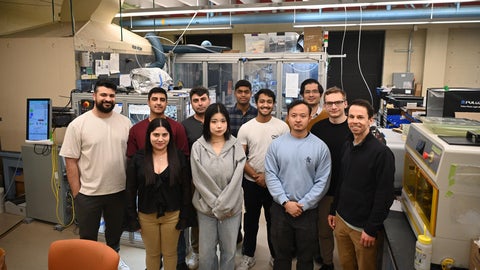
The Entangler | Inside Spring 2025

Chair's Message
Welcome to the Spring 2025 edition of the Entangler
Features

Evidence Mounting That Dark Energy Evolves Over Time
New results from the Dark Energy Spectroscopic Instrument show dark energy may currently be weakening
According to the Standard Model of Cosmology, the expansion of our universe is driven by the simplest possible version of dark energy: an unchanging ‘cosmological constant’ called lambda. That longstanding model may be about to change.

Taylor Pacholko Helps Launch National Quantum Education Project
Physics and Astronomy’s Taylor Pacholko is helping bring quantum science to classrooms across Canada through the Quantum Explorations Student Toolbox (QuEST) project. In collaboration with IQC and the University of Toronto, the team secured USD$25,000 from the APS Innovation Fund to design hands-on kits that introduce students (from middle school to high school) to core quantum concepts like interference and superposition.

Bridging The Quantum Gap
As a world-leading expert in quantum and artificial intelligence, University of Waterloo Science alum Dr. Roger Melko, BSc ’00 (Physics), MSc ’01 (Physics), consistently draws inspiration from recent technological revolutions and applies them to his innovative work in quantum science. Now, as a professor in Waterloo’s Department of Physics and Astronomy, his research uncovers new, unique connections between physics and machine learning.

Waterloo celebrates the remarkable career of Professor Donna Strickland
Donna Strickland, professor in the Physics and Astronomy department and Nobel Prize Laureate, has been named University Professor by the University of Waterloo. This designation recognizes exceptional scholarly achievement and international preeminence, both of which Strickland exemplifies.

Ideal semimetallic Weyl ferromagnet finally realized experimentally
In 2011, Physics Professor Anton Burkov theoretically predicted a way to engineer a Weyl semimetal from a topological semiconductor. Long thought to have been forgotten, recent work published in Nature has demonstrated for the first time in the world, an ideal Weyl semimetal and thus marking a breakthrough in a decades-old problem of quantum materials.

Prof. Kostadinka Bizheva Named 2025 Optica Fellow
Congratulations to Professor Kostadinka Bizheva on being named a 2025 Optica Fellow for her exceptional contributions to optical imaging in ophthalmology. Bizheva has more than 20 years of experience conducting research and teaching in the field of biomedical optics. Her work is focused on designing optical imaging technology, called optical coherence tomography (OCT), for biomedical applications.
Meet our students

Advancing space exploration: Optimizing the next generation of space telescopes
Michelle Kao (she/her), a third-year Physics and Astronomy student, is the Faculty of Science Co-op Student of the Year as well as the 2024 Experiential & Work Integrated Learning Ontario (EWO) Co-op Student of the Year! Michelle made outstanding contributions at the National Research Council Canada, Herzberg Astronomy and Astrophysics Research Centre.

Blending a passion for aviation and astrophysics
While most students spend their undergraduate years grounded in textbooks, Chloe Muhl has been splitting her time between the classroom and the skies. Over the last four years as an Honours Science student, Muhl has been balancing academics with flight training, completing the Commerical Flight Training Program at Spectrum Airways in Burlington, where she now works as a Class 4 flight instructor teaching others how to fly.

PhysiX Girls Matter inspires future students
First-year Physics and Astronomy student Bushra Almalki chose the University of Waterloo for its top-ranked Physics program. What she didn’t expect is how quickly she would become involved in campus life and come full circle volunteering at an event that sparked her love for physics in elementary school.

Engineering a more resilient global energy system with nanoscience
Second-year Materials and Nanosciences student Nayla Qureshi is using her co-op placements as an opportunity to work on developing sustainable energy alternatives to combating climate change and building a more resilient global energy system. The hands-on research she’s doing in innovative labs under the guidance of renowned faculty is contributing to these solutions.
Clubs corner

New Year, New Room, Same Old FemPhys: A Look at Winter 2025
FemPhys kicked off 2025 with a redesigned club room layout with a new coffee machine and lounge area. Since then, FemPhys has run numerous events including the annual Mentoring Night, participation in the 2025 IUPAC GLobal Women’s Breakfast, and hosting of guest speakers such as Dr. Andre Issacs.

The Rocket Lab That Almost Took Off... Literally
This semester the PhysClub did something a little different and hosted a three-part event series called the Rocket Chronicles. This adventure brought physics together with duct tape, clay and just the right amount of chaos to be a lot of fun!

Nano Recap: Looking Back on MNS Society’s Winter 2025 Term
The MNS Society had a busy term filled with movie nights, lab events, a conference, and so much more. The much-anticipated MNS merch has also finally launched, and even alumni can get their hands on some!
SIN bin
Can you solve it? The Sir Isaac Newton Exam, as we all know and love it, continues to offer challenging problems to high school students around the world. Flex your Physics brains with this problem from a past Sir Isaac Newton Exam!

2006, Problem 4
A block of mass m = 2.25kg is pushed against a vertical wall by a force F which makes an angle of 36.9 degrees to the horizontal. If the coefficient of static friction between the block and the wall is µs = 0.25 what is the minimum force necessary to keep the block statio0nary?
1999, Problem 2
Han Solo is holding a rope which is supporting Princess Leia, of mass 55 alistones (an alien unit of mass), 3 zons (an alien unit of length) above the ground as shown. Han, of mass 80 alistones, is holding onto his spaceship, the Millennium Falcon...